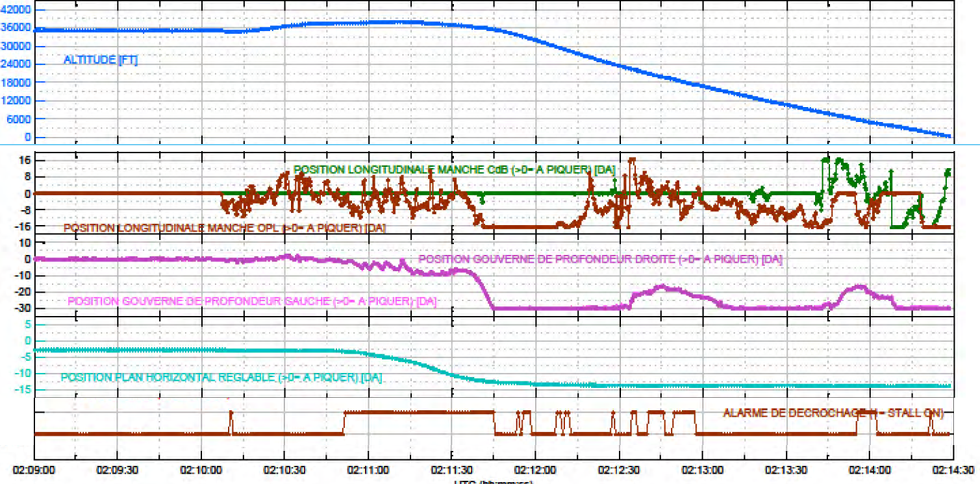Originally Posted by
airtren
Did you read the many posts on this Forum, regarding the Stall Warning bogus behavior? Did you understand them, if you read them ?
*All* of them are from people who either do not understand the Airbus FBW concept, have never flown a FBW Airbus and/or have a long-standing axe to grind with Airbus.
It's clear, from the BEA Report, and it's clear from many posts on this Forum, that all the Stall Warnings that occurred During the entire "Fall, and attempt to recover from Stall", after 2:12:45, when the plane was on its way down, from 35000 ft (FL350), with the two pilots and Captain in the cockpit, were giving the wrong information!!!
Not so - as I said on the other thread, there's only 1 positive correlation between nose-down input and the stall warning coming back on:
[EDIT : However it *could* appear that they match up if you flick between pages 110 and 111 in the PDF. This is because the graphics are not scaled identically in the X axis - see my corrected graphic below (note that the blocks of 15 seconds now match up). ]

The first 4 short returns of the Stall Warning (effectively a group of two) occur at approx 2:11:45 when the PF has the stick full-back, possibly as a result of the uncontrolled nose-down attitude that appears to be displayed in the "Assiette" trace.
The next stall warning occurs at 2:12:25, when the PF already has his stick back again after a brief nose-down input which does not trigger the stall warning, immediately followed by one (the only one in what you term the "recoverable" window) which does seem to correlate with a nose-down input, but notice that it comes on again 3 further times when the stick is either neutral or pulled nose-up.
It comes on again at 2:13:55, when the PNF has taken over control and already had the nose down input held for 15 seconds (but note the hesitancy - a positive nose-down gradually becomes relaxed before the stall warning comes back on, and if you correlate that with the CVR, that is about when the Captain says "You're pitching up", and the (former) PF questions whether nose-down is the right input to be making). At this point, both pilots begin to pull, and if their fate wasn't sealed before, it sure is now.
8 of these bogus Stall Warnings were between 35000ft and 6000ft, which is recoverable height.
I respectfully disagree. I also respectfully disagree that the warnings were "bogus" - they were very real! It was the dropouts (caused by the sensor becoming unable to provide readable data) that were the problem.
So, therefore, the La Tribune Article, and Le Figaro Article are making a lot of sense.
Because business tabloids and shock rags are generally well-known for the quality of their aviation coverage. Next time there's a crash in the US, perhaps we should use the Wall Street Journal and National Inquirer as our primary sources?
An Airbus 310, approaching Orly, Paris, in 1994 has recovered at 800ft, from a stall at 4100 ft (yes 30900 ft lower!!!), and from a pitch of 60 degrees, and only 30knots airspeed. Report & CVR transcript, CVR voice, video clips are available on the net.
I read that report a *long* time ago. There are several major differences that you need to take into account.
- This incident happened in broad daylight, meaning that the crew had a valid external reference, not the case with AF447
- While the THS did reach full deflection in the early phase of the accident (and again, briefly after the initial recovery), the AoA protection reduced the THS angle to -8.8 degrees, which assisted the recovery - again not the case with AF447
- The airspeed indications were always valid
- While not co-ordinating his actions with the Captain (who was PF), the PNF nevertheless did perform several actions to assist recovery (including noticing the THS angle and reducing accordingly)
a. the Stall Warning,
b. the unannounced trimming of the THS (Machinebird post #57, etc...)
c. the lack of AOA indication (BEA report),
d. the lack of sharing stick position information between PF and PNF (recent posts)
Stall warning - I disagree.
THS - poor training. The mechanics of autotrim *must* be taught as part of the conversion course, and if it has not been then that's a major oversight. Pilots are supposed to know how their aircraft works!
No other airliner of this type has an AoA indicator fitted as standard, you can't blame Airbus for that.
Don't get me started on the "back-driven sidesticks" argument again, I beg you. Suffice to say there are valid design reasons for not doing it and leave it at that.
Your graphs show clearly the 8 Stall Warnings, that between 35000 ft and 6000 ft, which is the recoverable window, have created confusion in the pilots and Captain minds.
Four (4) of these Wrong Stall Warnings were between 35000 ft and 30000ft - plenty of height to recover.
Look again - the PF has the stick full-back during those initial 4 Stall Warning blips.